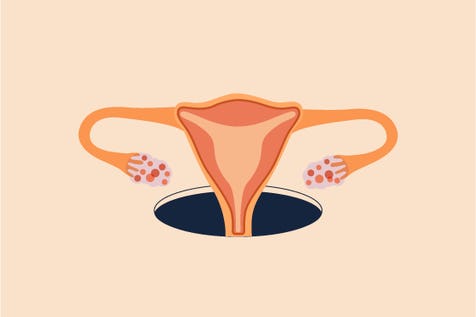What is PCOS?
Polycystic ovary syndrome (PCOS) is an endocrine condition characterised by an imbalance of hormones (1). The symptoms typically manifest as irregular menstrual cycles, increased levels of androgens (which are a type of hormone including testosterone), and small cysts in the ovaries.
Many of the common symptoms are a result of the increased levels of androgens in the body and can include excess facial and body hair (known as hirsutism), hair loss on the head, and acne. Androgens also contribute to the so-called cysts that form in the ovaries. These are not cysts in the true sense but follicles - which are the structures in the ovary that contain the developing eggs. The increased levels of androgens stimulate the smaller follicles in the ovary to grow but block the growth of larger follicles (2). This results in increased numbers of growing follicles (which can be seen on an ultrasound) but often less frequent and less predictable ovulation.
PCOS is very common and estimated to affect 6 - 10% of reproductive-aged women (1). However, more recent inclusion criteria for the diagnosis of PCOS suggest that the number of women affected may be closer to 20% (1, 3).
PCOS can also be associated with longer-term metabolic and cardiovascular risks such as obesity, heart disease, and type 2 diabetes which makes early diagnosis and treatment of PCOS especially important (4).
Is PCOS a condition of the ovaries?
Despite the name, PCOS is not simply a disorder of the ovaries. It is an endocrine disorder and impacts many systems in the body including reproduction, metabolism, and mood. Not everyone with PCOS develops ovarian cysts, but equally having polycystic ovaries alone does not necessarily mean you have PCOS. In fact, around 23% of women are thought to have polycystic ovaries without any of the other signs of PCOS (5). Instead, PCOS diagnosis is generally based on the presence of two out of three of the following criteria (6):
-
Irregular cycles (as a result of ovulatory dysfunction)
-
Androgen excess and associated symptoms
-
Polycystic ovaries on ultrasound
What are the signs and symptoms of PCOS?
The signs and symptoms of PCOS result from an imbalance of different hormones including increased levels of luteinizing hormone (LH), insulin, and androgens such as testosterone. These impact many different systems in the body and as a result, everyone’s experience can be very different. The symptoms that are most commonly experienced include:
-
Irregular menstrual cycles (typically missed or infrequent periods as a result of not ovulating)
-
Periods that are very heavy (or very light)
-
Unwanted hair growth on the face or body
-
Thinning hair on the head
-
Weight gain
-
Depression or anxiety
-
Difficulty getting pregnant
PCOS and other health conditions
In addition to the symptoms that you experience, there can be other longer-term complications of PCOS including:
-
Decreased sensitivity to insulin
-
Type 2 diabetes
-
Cardiovascular disease
-
Abnormal uterine bleeding - women with PCOS who are anovulatory are exposed to unopposed estrogen (usually balanced by progesterone produced as a result of ovulation) and are at risk of both prolonged heavy bleeding and changes in the endometrium leading to endometrial hyperplasia or cancer
-
Sleep apnea (disrupted breathing during sleep)
What causes PCOS?
At the moment the cause of PCOS still remains unclear. A big hurdle facing researchers investigating PCOS is unpicking the cause and effect of the different hormonal imbalances that occur. Increased levels of androgen however appear to be the main driving force behind symptoms of PCOS. Exactly how and why androgen production is increased is not yet understood but it is thought that genetics, lifestyle and environmental factors (or a combination of all three) may play a role. One hypothesis is that disrupted gonadotropin signalling (LH and FSH) leads to increased levels of LH which is the hormone responsible for androgen production in the ovary (7).
Genetics
Studies have shown that PCOS can be genetically inherited. In one study researchers found that of women with PCOS 24% of mothers and 32% of sisters also had the disorder (8). Another study found that identical twins were twice as likely to both have PCOS than non-identical twins or sisters (9). Despite the proven genetic link of PCOS it is still unclear exactly which genes are involved. A large-scale genetics study however revealed some potential candidates including genes that play a role in gonadotropin (LH and FSH) signalling, as well as those that regulate the production of androgens in the ovary and the action of insulin on the body (10).
Lifestyle, insulin resistance and androgens
Around two thirds of women with PCOS suffer from insulin resistance (11). Insulin is the hormone important for processing glucose in the body but also works alongside LH in the ovary to produce androgens (1). When someone is insulin resistant their body has a lower sensitivity to insulin for processing glucose. To adjust for this, more insulin is produced. In turn, this results in the production of more androgens in the ovary and worsening of PCOS symptoms (12). Insulin resistance can be linked to weight gain and sometimes symptoms of PCOS only become apparent after someone who is predisposed to PCOS (for example through genetics) gains a lot of weight. Improving insulin resistance (through weight loss and exercise), however, can often cause levels of insulin to fall and in turn, reduce the amount of androgen produced by the ovary leading to improved PCOS symptoms.
Environment
Certain environmental factors are thought to play a role in the development of PCOS. These factors can range from environmental toxins such as nicotine in cigarette smoke, exposure to various environmental pharmaceuticals as well as compounds known as endocrine-disrupting chemicals (EDCs), to diet (13). EDCs such as bisphenol A (BPA) are found in many plastic household items and are of particular interest to researchers. EDCs mimic the hormones found in the body and evidence suggests that prenatal exposure (exposure during pregnancy) to such compounds can programme PCOS before birth. Studies have even revealed increased levels of BPA in the blood serum of women with PCOS suggesting that exposure to such chemicals in individuals genetically predisposed to the disorder could cause the onset of symptoms (14).
Can PCOS be treated?
PCOS is a lifelong condition but once diagnosed symptoms can be managed. There is no one size fits all treatment for PCOS. Instead, the approach will depend on the individual’s symptoms and personal goals for treatment.
Lifestyle changes
Lifestyle modification through changes to diet or levels of physical activity can have a big impact on the symptoms of PCOS. Studies have shown that losing as little as 5% of excess weight can reduce levels of androgens and re-establish ovulation as well as lessen other PCOS symptoms including unwanted hair growth (15, 16).
Medication
Medications for PCOS are generally targeted at improving insulin resistance, reducing levels of androgens (or blocking the effects of them) and inducing ovulation, as well as regulating the menstrual cycle (17). Combined oral contraceptives (OCs) are often a first-line treatment to regulate the menstrual cycle in addition to limiting excess hair growth and improving acne by suppressing ovarian androgen production. Through inducing a regular menstrual period OCs also protect the endometrium against abnormal cell growth, and hyperplasia or cancer. Drugs such as spironolactone that block the effects of androgen can also be prescribed to reduce unwanted hair growth and acne. Metformin acts by increasing sensitivity to insulin and is effective in both reducing body weight and reducing androgen levels (18). People who are trying to get pregnant can be prescribed a drug such as clomiphene alone or in combination with Metformin to help them ovulate (19).
PCOS, ovulation and inne
Ovulation problems, including anovulatory cycles, are the most common reason for infertility. PCOS accounts for over 90% of cases of anovulation (20). Unless you are tracking your ovulation however, you may be unaware that you are experiencing issues as there is often still bleeding in anovulatory cycles. Normal menstrual bleeding is a result of a drop in progesterone that occurs because of the breakdown of the corpus luteum. As there is no progesterone in an anovulatory cycle, the bleeding – known as estrogen breakthrough bleeding - is caused by the inability of estrogen to support the growing endometrium (21). Women can use inne as a way to confirm that ovulation has taken place. This is done by detecting the increase in progesterone levels after ovulation has taken place. inne can also be used to track the days you have your period so you can keep a tab on the length and regularity of your menstrual cycle.
References
-
Escobar-Morreale HF. Polycystic ovary syndrome: definition, aetiology, diagnosis and treatment. Nat Rev Endocrinol. 14, 270-284 (2018).
-
Duncan WC. A guide to understanding polycystic ovary syndrome (PCOS). J Fam Plann Reprod Health Care. 40, 217-225 (2014).
-
Yildiz, BO, Bozdag G, Yapici Z, Esinler I. & Yarali H. Prevalence, phenotype and cardiometabolic risk of polycystic ovary syndrome under different diagnostic criteria. Hum. Reprod. 27, 3067–3073 (2012).
-
Lobo RA, Carmina E. The importance of diagnosing the polycystic ovary syndrome. Ann Intern Med. 132, 989-93 (2000).
-
Polson DW, Adams J, Wadsworth J, Franks S. Polycystic ovaries--a common finding in normal women. Lancet. 1, 870-2 (1988).
-
The Rotterdam ESHRE/ASRM-sponsored PCOS Consensus Workshop Group. Revised 2003 consensus on diagnostic criteria and long term health risks related to polycystic ovary syndrome (PCOS). Hum Reprod. 19, 41–47 (2004).
-
Yen SS. The polycystic ovary syndrome. Clin Endocrinol. 12, 177-207 (1980).
-
Kahsar-Miller MD, Nixon C, Boots LR, Go RC & Azziz R. Prevalence of polycystic ovary syndrome (PCOS) in first-degree relatives of patients with PCOS. Fertil. Steril. 75, 53–58 (2001).
-
Vink JM, Sadrzadeh S, Lambalk CB. & Boomsma DI. Heritability of polycystic ovary syndrome in a Dutch twin-family study. J. Clin. Endocrinol. Metab. 91, 2100–2104 (2006).
-
Azziz R. PCOS in 2015: New insights into the genetics of polycystic ovary syndrome. Nat Rev Endocrinol. 12, 74-5 (2016).
-
Randeva HS, Tan BK, Weickert MO, Lois K, Nestler JE, Sattar N, Lehnert H. Cardiometabolic aspects of the polycystic ovary syndrome. Endocr Rev. 33, 812-841 (2012).
-
Barbieri RL, Makris A, Randall RW, Daniels G, Kistner RW, Ryan KJ. Insulin stimulates androgen accumulation in incubations of ovarian stroma obtained from women with hyperandrogenism. J Clin Endocrinol Metab. 62, 904-10 (1986).
-
Merkin SS, Phy JL, Sites CK, Yang D. Environmental determinants of polycystic ovary syndrome. Fertil Steril. 106, 16-24 (2016).
-
Kandaraki E, Chatzigeorgiou A, Livadas S, Palioura E, Economou F, Koutsilieris M, Palimeri S, Panidis D, Diamanti-Kandarakis E. Endocrine disruptors and polycystic ovary syndrome (PCOS): elevated serum levels of bisphenol A in women with PCOS. J Clin Endocrinol Metab. 96, E480-E484 (2011).
-
Pasquali R, Antenucci D, Casimirri F, et al. Clinical and hormonal characteristics of obese amenorrheic hyperandrogenic women before and after weight loss. J Clin Endocrinol Metab. 68, 173-179 (1989).
-
Crosignani PG, Colombo M, Vegetti W, Somigliana E, Gessati A, Ragni G. Overweight and obese anovulatory patients with polycystic ovaries: parallel improvements in anthropometric indices, ovarian physiology and fertility rate induced by diet. Hum Reprod. 18, 1928-1932 (2003).
-
Radosh L. Drug treatments for polycystic ovary syndrome. Am Fam Physician. 79, 671-676 (2009).
-
Naderpoor N, Shorakae S, de Courten B, Misso ML, Moran LJ, Teede HJ. Metformin and lifestyle modification in polycystic ovary syndrome: systematic review and meta-analysis. Hum Reprod Update. 21, 560-574 (2015).
-
Siebert TI, Kruger TF, Steyn DW, Nosarka S. Is the addition of metformin efficacious in the treatment of clomiphene citrate-resistant patients with polycystic ovary syndrome? A structured literature review. Fertil Steril. 86, 1432-7 (2006).
-
Balen AH & Rutherford AJ. Managing anovulatory infertility and polycystic ovary syndrome. BMJ. 335, 663–666 (2007).
-
Jones K, Sung S. Anovulatory Bleeding. In: StatPearls (Updated 2020).




